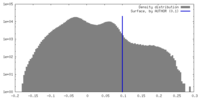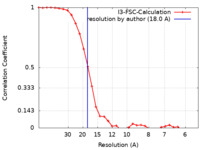+ Open data
Open data
- Basic information
Basic information
| Entry |  | |||||||||
|---|---|---|---|---|---|---|---|---|---|---|
| Title | ACE2 dimer bound to two RBD in membrane | |||||||||
 Map data Map data | ||||||||||
 Sample Sample |
| |||||||||
 Keywords Keywords | Complex / VIRAL PROTEIN / Cell Receptor | |||||||||
| Biological species |  | |||||||||
| Method | subtomogram averaging / cryo EM / Resolution: 18.0 Å | |||||||||
 Authors Authors | Qin Z / Li W / Grunst MW / Mothes W | |||||||||
| Funding support |  United States, 1 items United States, 1 items
| |||||||||
 Citation Citation |  Journal: Science / Year: 2024 Journal: Science / Year: 2024Title: Structure and inhibition of SARS-CoV-2 spike refolding in membranes. Authors: Michael W Grunst / Zhuan Qin / Esteban Dodero-Rojas / Shilei Ding / Jérémie Prévost / Yaozong Chen / Yanping Hu / Marzena Pazgier / Shenping Wu / Xuping Xie / Andrés Finzi / José N ...Authors: Michael W Grunst / Zhuan Qin / Esteban Dodero-Rojas / Shilei Ding / Jérémie Prévost / Yaozong Chen / Yanping Hu / Marzena Pazgier / Shenping Wu / Xuping Xie / Andrés Finzi / José N Onuchic / Paul C Whitford / Walther Mothes / Wenwei Li /   Abstract: The severe acute respiratory syndrome coronavirus 2 (SARS-CoV-2) spike protein binds the receptor angiotensin converting enzyme 2 (ACE2) and drives virus-host membrane fusion through refolding of its ...The severe acute respiratory syndrome coronavirus 2 (SARS-CoV-2) spike protein binds the receptor angiotensin converting enzyme 2 (ACE2) and drives virus-host membrane fusion through refolding of its S2 domain. Whereas the S1 domain contains high sequence variability, the S2 domain is conserved and is a promising pan-betacoronavirus vaccine target. We applied cryo-electron tomography to capture intermediates of S2 refolding and understand inhibition by antibodies to the S2 stem-helix. Subtomogram averaging revealed ACE2 dimers cross-linking spikes before transitioning into S2 intermediates, which were captured at various stages of refolding. Pan-betacoronavirus neutralizing antibodies targeting the S2 stem-helix bound to and inhibited refolding of spike prehairpin intermediates. Combined with molecular dynamics simulations, these structures elucidate the process of SARS-CoV-2 entry and reveal how pan-betacoronavirus S2-targeting antibodies neutralize infectivity by arresting prehairpin intermediates. | |||||||||
| History |
|
- Structure visualization
Structure visualization
| Supplemental images |
|---|
- Downloads & links
Downloads & links
-EMDB archive
| Map data |  emd_42876.map.gz emd_42876.map.gz | 1.8 MB |  EMDB map data format EMDB map data format | |
|---|---|---|---|---|
| Header (meta data) |  emd-42876-v30.xml emd-42876-v30.xml emd-42876.xml emd-42876.xml | 14 KB 14 KB | Display Display |  EMDB header EMDB header |
| FSC (resolution estimation) |  emd_42876_fsc.xml emd_42876_fsc.xml | 3 KB | Display |  FSC data file FSC data file |
| Images |  emd_42876.png emd_42876.png | 86.5 KB | ||
| Filedesc metadata |  emd-42876.cif.gz emd-42876.cif.gz | 4.1 KB | ||
| Others |  emd_42876_half_map_1.map.gz emd_42876_half_map_1.map.gz emd_42876_half_map_2.map.gz emd_42876_half_map_2.map.gz | 1.8 MB 1.8 MB | ||
| Archive directory |  http://ftp.pdbj.org/pub/emdb/structures/EMD-42876 http://ftp.pdbj.org/pub/emdb/structures/EMD-42876 ftp://ftp.pdbj.org/pub/emdb/structures/EMD-42876 ftp://ftp.pdbj.org/pub/emdb/structures/EMD-42876 | HTTPS FTP |
-Validation report
| Summary document |  emd_42876_validation.pdf.gz emd_42876_validation.pdf.gz | 844.2 KB | Display |  EMDB validaton report EMDB validaton report |
|---|---|---|---|---|
| Full document |  emd_42876_full_validation.pdf.gz emd_42876_full_validation.pdf.gz | 843.8 KB | Display | |
| Data in XML |  emd_42876_validation.xml.gz emd_42876_validation.xml.gz | 8.5 KB | Display | |
| Data in CIF |  emd_42876_validation.cif.gz emd_42876_validation.cif.gz | 10.9 KB | Display | |
| Arichive directory |  https://ftp.pdbj.org/pub/emdb/validation_reports/EMD-42876 https://ftp.pdbj.org/pub/emdb/validation_reports/EMD-42876 ftp://ftp.pdbj.org/pub/emdb/validation_reports/EMD-42876 ftp://ftp.pdbj.org/pub/emdb/validation_reports/EMD-42876 | HTTPS FTP |
-Related structure data
- Links
Links
| EMDB pages |  EMDB (EBI/PDBe) / EMDB (EBI/PDBe) /  EMDataResource EMDataResource |
|---|
- Map
Map
| File |  Download / File: emd_42876.map.gz / Format: CCP4 / Size: 2 MB / Type: IMAGE STORED AS FLOATING POINT NUMBER (4 BYTES) Download / File: emd_42876.map.gz / Format: CCP4 / Size: 2 MB / Type: IMAGE STORED AS FLOATING POINT NUMBER (4 BYTES) | ||||||||||||||||||||||||||||||||||||
|---|---|---|---|---|---|---|---|---|---|---|---|---|---|---|---|---|---|---|---|---|---|---|---|---|---|---|---|---|---|---|---|---|---|---|---|---|---|
| Projections & slices | Image control
Images are generated by Spider. | ||||||||||||||||||||||||||||||||||||
| Voxel size | X=Y=Z: 2.692 Å | ||||||||||||||||||||||||||||||||||||
| Density |
| ||||||||||||||||||||||||||||||||||||
| Symmetry | Space group: 1 | ||||||||||||||||||||||||||||||||||||
| Details | EMDB XML:
|
-Supplemental data
- Sample components
Sample components
-Entire : ACE2 dimer bound to two RBD in membrane
| Entire | Name: ACE2 dimer bound to two RBD in membrane |
|---|---|
| Components |
|
-Supramolecule #1: ACE2 dimer bound to two RBD in membrane
| Supramolecule | Name: ACE2 dimer bound to two RBD in membrane / type: complex / ID: 1 / Parent: 0 / Macromolecule list: #1-#2 |
|---|---|
| Source (natural) | Organism:  |
-Experimental details
-Structure determination
| Method | cryo EM |
|---|---|
 Processing Processing | subtomogram averaging |
| Aggregation state | particle |
- Sample preparation
Sample preparation
| Buffer | pH: 7.4 |
|---|---|
| Vitrification | Cryogen name: ETHANE |
- Electron microscopy
Electron microscopy
| Microscope | FEI TITAN KRIOS |
|---|---|
| Specialist optics | Phase plate: VOLTA PHASE PLATE / Energy filter - Name: GIF Quantum LS / Energy filter - Slit width: 20 eV |
| Image recording | Film or detector model: GATAN K3 BIOQUANTUM (6k x 4k) / Average electron dose: 3.0 e/Å2 |
| Electron beam | Acceleration voltage: 300 kV / Electron source:  FIELD EMISSION GUN FIELD EMISSION GUN |
| Electron optics | C2 aperture diameter: 50.0 µm / Calibrated defocus max: 0.8 µm / Calibrated defocus min: 0.2 µm / Illumination mode: OTHER / Imaging mode: BRIGHT FIELD / Cs: 2.7 mm / Nominal defocus max: 0.5 µm / Nominal defocus min: 0.5 µm / Nominal magnification: 64000 |
| Sample stage | Specimen holder model: FEI TITAN KRIOS AUTOGRID HOLDER / Cooling holder cryogen: NITROGEN |
| Experimental equipment |  Model: Titan Krios / Image courtesy: FEI Company |
 Movie
Movie Controller
Controller









 Z (Sec.)
Z (Sec.) Y (Row.)
Y (Row.) X (Col.)
X (Col.)





















